Red Cloud Works to Increase
Native American Representation in the Sciences
posted on January 29, 2014
Less than one percent. Today Native American students make up less than one percent of those earning advanced degrees in science and engineering, according to a National Science Foundation study. Facing statistics like that, for many Native students the barriers to pursuing a career in the sciences seem insurmountable.
But three years ago, Red Cloud set out to change that fact—starting right here on the Pine Ridge Reservation.
With the help of the Toyota USA Foundation, Red Cloud launched a new initiative to encourage Lakota students to pursue their dreams of earning advanced degrees in the sciences. In Lakota, the program is called Uŋčí Makȟá Uŋglúhapi Tȟokátakiya Wičhóuŋčhaǧe Uŋkáblezapi, meaning “Keepers of Grandmother Earth, We Look to the Future Generations”—and it aims to empower Lakota students with a strong science education to prepare them for their future careers. Today, you can see the results of this extraordinary initiative all over campus.
|
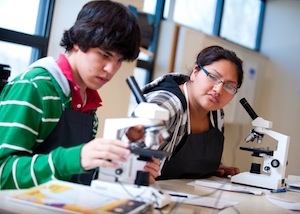 In the high school, walking by a science classroom, you can see juniors and seniors conducting chemistry, biology and physics experiments on the latest equipment—and recording their results on a set of new iPads. In the high school, walking by a science classroom, you can see juniors and seniors conducting chemistry, biology and physics experiments on the latest equipment—and recording their results on a set of new iPads.
|
|
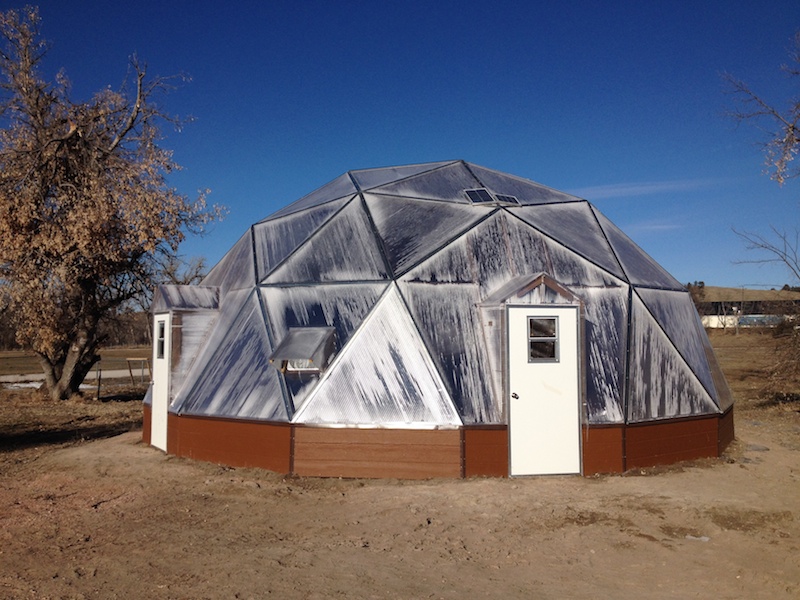 Just past Red Cloud’s football field, you can see the roof of a new greenhouse shining in the sunlight. Built in the fall of 2013, this new resource is already encouraging experiential learning in classes from botany to health—and will enrich science education at Red Cloud for years to come. Just past Red Cloud’s football field, you can see the roof of a new greenhouse shining in the sunlight. Built in the fall of 2013, this new resource is already encouraging experiential learning in classes from botany to health—and will enrich science education at Red Cloud for years to come.
|
|
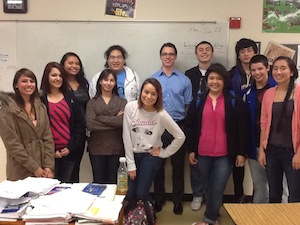 On campus, you might also find a visiting Native scientist speaking to a classroom of high school students about what it takes to break into the science field. In recent years, Red Cloud has brought scientists like Dr. Allyn Kaufmann, a senior scientist for Procter and Gamble, and Connie Giroux, lab manager at the Sanford Underground Lab, into the classroom to mentor and inspire students. On campus, you might also find a visiting Native scientist speaking to a classroom of high school students about what it takes to break into the science field. In recent years, Red Cloud has brought scientists like Dr. Allyn Kaufmann, a senior scientist for Procter and Gamble, and Connie Giroux, lab manager at the Sanford Underground Lab, into the classroom to mentor and inspire students.
|
|
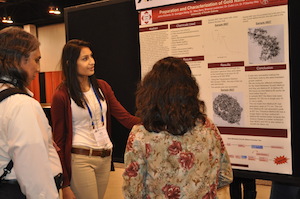 And after school, you can find the Red Cloud science club preparing for their next national science competition. Over the last three years, Red Cloud students have traveled as far as Minneapolis, Denver and Alaska to attend meetings of the American Indian Science and Engineering Society (AISES), the leading organization working to increase Native representation in the science, technology, engineering and math (STEM) fields. And after school, you can find the Red Cloud science club preparing for their next national science competition. Over the last three years, Red Cloud students have traveled as far as Minneapolis, Denver and Alaska to attend meetings of the American Indian Science and Engineering Society (AISES), the leading organization working to increase Native representation in the science, technology, engineering and math (STEM) fields.
|
But the ultimate impact of the initiative, says Red Cloud High School Principal Robin Johnson, is the dramatic increase in the number of Red Clouds students who plan to pursue careers in science.
“Nearly half of our graduating seniors in 2013 went off to college with plans to study the sciences, from medicine to nursing to psychology and veterinary care,” she explains. “That burst of interest is directly related to Toyota’s investment in Red Cloud’s science program. Now our students believe its possible to achieve their dream of a career in science. And with this strong foundation in science education, they truly can.”
Today, more and more Red Cloud students are preparing to change the face of the science profession in America. Here just a few share why they love learning about science at Red Cloud, and what their plans are for the future.
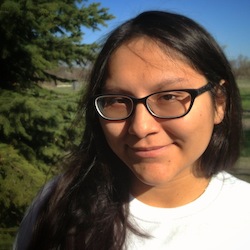 Mickie Hudspeth ‘13, a recent Red Cloud graduate, is taking her science education to the next level at Augustana College in Sioux Falls. She is studying nursing, and plans to become a midwife. Her time at Red Cloud, she says, is helping her work toward that dream.
Mickie Hudspeth ‘13, a recent Red Cloud graduate, is taking her science education to the next level at Augustana College in Sioux Falls. She is studying nursing, and plans to become a midwife. Her time at Red Cloud, she says, is helping her work toward that dream.
Prepared for the future: “My college classes can be really difficult, but I feel like my experience in Red Cloud’s lab really prepared me for my college classes and has given me an advantage in keeping my grades up. The other day I actually helped a student from South Africa, who is in my class, learn how to pipette. It was a great experience.”
Advanced knowledge: “I learned how to correctly use a pipette during labs at Red Cloud. The other day, in one of my biology classes at Augustana College, my instructor spent 20 minutes explaining the correct use to the rest of the class because the majority of the students either did not know how to use them, or had only used older versions and were not familiar with the new types—the same we had used at Red Cloud.”
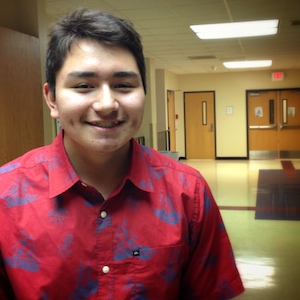 Bobby Pourier ‘16 loves to experiment in Red Cloud’s updated labs, and believes that it's Red Cloud's unique facilities that inspire him and his peers to pursue science in higher education.
Bobby Pourier ‘16 loves to experiment in Red Cloud’s updated labs, and believes that it's Red Cloud's unique facilities that inspire him and his peers to pursue science in higher education.
Hands-on learning: “At the beginning of the year we were learning about chemical bonds. I really found it to be a difficult concept, but once we got up from our desks and put the textbook’s words to the test in our new lab, it all clicked for me. I realized how hard it would be to learn if we didn’t have the lab.”
Exploring in science club: “Today in Science Club we’re going using liquid carbon dioxide and gallium, a low-melting-temperature metal...It’s really a special thing. You would never be able to do stuff like that by yourself in everyday life. It’s this sort of thing that gets me excited about learning science and going to class.”
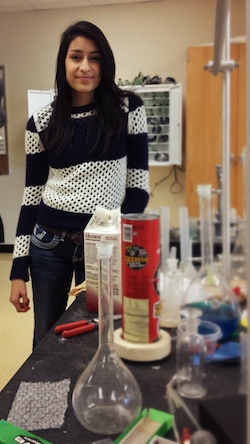 Jamie Richards ‘15 is always excited to explore new hypotheses, and is gearing up for a career in health care.
Jamie Richards ‘15 is always excited to explore new hypotheses, and is gearing up for a career in health care.
Testing theories: “There's just something about forming a hypothesis, testing it and seeing if you’re right that I really love. Any time we get to go in the lab I get excited.”
The excitement of chemistry: “My favorite project was in chemistry last year when we had to determine what different types of chemicals were present in a solution and classify them into groups. There was another lab called “Elephant Toothpaste” where we used different chemicals to make a huge foaming soapy paste—which looked like it could be for elephants. It was really fun.”
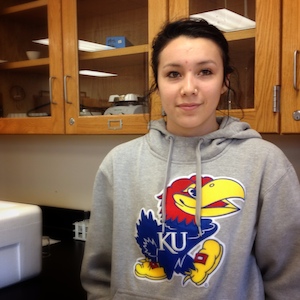 Myriam Rama ‘15 took her science skills to a university lab internship last summer, and is looking forward to studying chemistry in the future.
Myriam Rama ‘15 took her science skills to a university lab internship last summer, and is looking forward to studying chemistry in the future.
Ahead of the game: “During my classes I learned how to properly mix and dispose of solutions, how to safely work with propane gas and generally how to work in a lab setting. I got into the Research Apprenticeship Program at University of South Dakota last summer and having these skills under my belt was really helpful for me when I arrived in the university labs. I felt like I already knew what I was doing.”
All Content, ©Red Cloud Indian School, 2014
